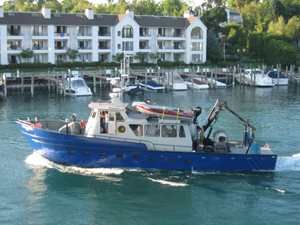|
Aug. 16, 2016
Contact: Randy Claramunt, 231-547-2914 (ext. 224) or Elyse Walter, 517-284-5839
High-tech survey of Lake Michigan's prey fish community helps with future decisions

The Department of Natural Resources is preparing to conduct its annual hydro-acoustic (sonar) and mid-water trawl survey of alewives and other prey fishes in Lake Michigan this month to determine the status of these key components of the Lake Michigan ecosystem.
The survey is conducted on board the DNR’s Survey Vessel (S/V) Steelhead, based out of Charlevoix, in conjunction with the U.S. Geological Survey’s (USGS) Great Lakes Science Center’s R/V Arcticus. The survey is done at night starting in mid-August and usually takes about three weeks to complete.
Once completed, estimates of total prey fish abundance are used by fisheries managers in balancing predator-prey dynamics. Managers adjust fish-stocking rates to keep alewife abundance in balance with lake productivity levels.
Biologist can estimate the number or biomass (total weight) of alewives in Lake Michigan in just a few weeks thanks to technological advances in fisheries surveys that have occurred in the last 10 years and the DNR’s partnership with USGS.
“In a given night of sampling we can trawl up to 5 miles at depths ranging from 30 to 250 feet and collect up to 100 miles of acoustic data,” said Randy Claramunt, DNR fisheries research biologist. “All information is recorded digitally and immediately available for analysis.”
While the S/V Steelhead is surveying Michigan’s waters of Lake Michigan, the USGS Great Lakes Science Center’s R/V Arcticus will be surveying the western shoreline using the same methods.
“Cooperation with the DNR makes this survey possible,” said Dave Warner, USGS Great Lakes Science Center research biologist. “If we did not have the ability to use two vessels, then our uncertainty in estimates of prey fish would be much higher because we would not be able to cover an adequate amount of the lake at the same time.”
Lake Michigan prey fish abundance and distribution can vary greatly from year to year. For example, alewife biomass averages around 38,500 tons (more than 86 million pounds). But the maximum change observed from one year to another because of the DNR/USGS survey can be even more than that – up to 40,000 tons (100 million pounds).
Information collected this August will be useful as fisheries managers continue to evaluate next steps for Lake Michigan’s fish populations – including rebalancing stocking efforts to better align with prey availability.
For more information on Lake Michigan’s salmon issues, visit www.michigan.gov/fishing.
/Editors' note: An accompanying photo is available below for download. A suggested caption follows.
The Survey Vessel Steelhead, picture here, has begun its annual survey of prey fish on Lake Michigan./
The Michigan Department of Natural Resources is committed to the conservation, protection, management, use and enjoyment of the state’s natural and cultural resources for current and future generations. For more information, go to www.michigan.gov/dnr.
|







